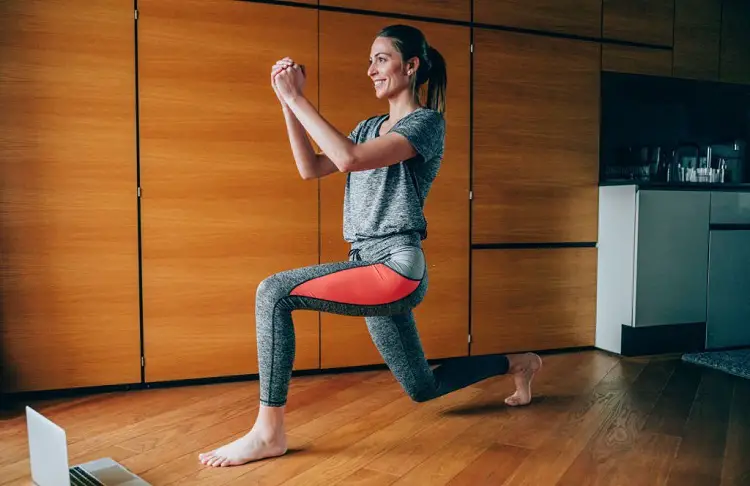Pregnancy is a journey whose result justifies the means because, in the end, the sight of the newborn baby takes away all the pains experienced during the journey.
As the time for birthing a child draws near, the body increases in size and weight, and most times, a pregnant mother can’t wait to end the journey.
The tension and pains increase when the delivery date passes without signs of labor, hence the use of squatting to induce labor.
Now the big question is how many squats to induce labor? Read on.
Can Pregnant Women Do Squats?
Are you wondering if pregnant women can squat? Well, it is safe for pregnant women to squat, but safety tips must be adhered to, and the correct squatting method or procedure followed.
Before you begin your squatting exercise, discuss it with your doctor and get their approval and remember that you must not overwork yourself.
While squatting, if you experience discomfort, do away or reduce the weights you are using or try reducing the range of motion.
If continuous pain is still felt, especially in the knee, then you have no choice but to stop the exercise.
Can squatting induce labor?
There are many tales about squatting and labor induction. Still, the truth remains that the only scientifically and clinically proven method of labor induction is the activity of the hormone oxytocin.
Can Squats help during labor?
Yes, squatting helps labor by opening the pelvic area, strengthening the muscles area giving enough space that enables easy movement of the baby.
Once this happens, the baby can descend, and cervical dilation starts inducing labor.
How Many Squats To Induce Labor
There hasn’t been a consensus on the number of squats to induce labor.
While some health experts suggest 300 squats daily to help induce labor, others recommend that at least 5 minutes should be invested into squatting every day to enable it to help induce labor.
Benefits of squatting during pregnancy
According to the APA (American Pregnancy Association), squats during pregnancy as it helps relax your pelvic muscles and aids in opening the birth canal.
Here are some of the benefits that come with the use of squatting to induce labor, and they include:
- It helps in the opening of the pelvic muscles.
- The baby’s movement into the birth canal is made easy due to more room created by squatting.
- Reduction of labor time by 11 minutes
- Strengthening the muscles of the legs and makes labor easier
- It reduces constipation.
- It builds strength in the lower body.
- It improves posture
- It helps with spinal alignment.
- It helps with hip mobility.
Read Also: How To Stimulate Nipples To Induce Labor
How To Squat During Pregnancy To Aid Labor
Knowing the right way to squat is as important as the squatting exercise itself because the wrong squatting method may cause an accident or even harm the mother and child.
Here are different squat exercises to ensure you and your child’s safety is not compromised at this last stage of pregnancy.
Goblet squat

- Stand with your feet slightly wider than hips apart, toes slightly turned out. As you hold one heavy dumbbell or kettlebell in front of your chest, bend your elbows and tuck them into your sides.
- Inhale as you bend your knees and draw your hips back and your torso forward into a squat position.
- As you stand, brace your core and lift your pelvic floor as you press through your heels. We recommend you do 8 to 10 reps for 2 to 3 sets.
Supported split squat

- While holding onto a stable surface like the back of a chair or a wall, raise your right leg and left heel simultaneously. Keep your torso upright.
- Keep your weight evenly distributed as you lower into a split squat by bending both knees. Ensure your back heel is elevated at all times.
- Stroke both legs straight without locking the knees as you rise back to standing. Repeat the process before switching to the opposite side with the left leg in front. We recommend doing 8 to 10 reps on each side for 2 to 3 sets.
Squat with high to low reach
- You should stand with your feet slightly wider than hip-distance apart with your toes turned out, holding a light-to-medium weight dumbbell in each hand.
- Press both dumbbells out and down in front of you as you squat, palms facing down. Keep your arms stretched below shoulder height, as though you are placing something on a low shelf.
- Stand with your heels lifted at the top and exhale with your heels pressed into the ground.
- Press both dumbbells out and up in front of you until your arms are stretched above shoulder height as if you were placing something on a shelf. We recommend doing 10 to 15 reps for 2-3 sets.
Lateral squat with loop resistance band

- Wrap a mini loop resistance band around your thighs. Begin by standing with your feet hip-distance apart.
- Take a step out to the side with your right foot and bend both knees, landing in a wider squat position, sending your hips slightly back. Then move your right foot back into a return to starting position.
- Do the same on the other side, taking a step out with the left foot in a wide squat. Continue moving sides. We recommend doing 10 reps on each side for 2 to 3 sets.
Wall squat

- Stand with your back against a wall. Move your feet away from the wall and bend your knees as if sitting in a chair. Ensure the back of your head, shoulders, ribs, and pelvis are touching the wall.
- Lower your hands to your belly bump, and maintain this position.
- Take deep, diaphragmatic breaths – inhale to expand the rib cage fully and exhale to hug the baby toward your spine. Actively press the wall with your lower back to relieve pressure in the pelvis.
- Maintain this position for 30 seconds to 1 minute before slowly rising back up to stand. Rest for 15 seconds. You can do this for 2 to 3 sets.
Read Also: What To Eat Before Labor (Foods To Try)
Other Exercises That Help Induce Labor Naturally
Walking
Walking, believe it or not, is extremely beneficial during pregnancy! It is a simple, low-impact exercise that most women can perform and induces uterine contractions. Walking also helps move your baby to the lower uterus, dilating the cervix and inducing labor.
Stair climbing
While you may have avoided taking stairs for most of your pregnancy, it may play a huge role in the final stage of labor.
Climbing stairs (slowly and carefully; we don’t want any accidents involving falling or slipping) can open up your pelvis, start cervix dilation, descend the baby to the birth canal, and naturally induce labor.
Butterflies
You will be familiar with this simple stretching exercise if you work out regularly. It stretches your back, pelvis, and thighs, increasing blood flow, making them more flexible, and making labor easier.
Kegel Exercises
Kegel exercises target the pelvic floor muscles, the most important muscles during childbirth. Kegels for 10 minutes twice or thrice a day strengthen the muscles, making childbirth easier.
Pelvic Tilt
This is one of the most popular and simple exercises for naturally inducing labor. You can do it twice daily to prepare your pelvic muscles for comfortable labor and delivery.
Leaning
Another great stretch for your back and pelvic muscles to aid labor is leaning (towards a wall or an exercise ball).
Signs that you shouldn’t squat during pregnancy
In as much as squatting aids labor by preparing the body, it is not meant for everyone, especially when you experience one or more of the signs listed below.
1. Pain
Suppose you experience pain in your knee, back, hips or groins. In that case, you don’t need to continue the exercise until after seeing your trainer or physical therapist for professional advice.
2. V. bleeding
Once you notice any form of bleeding from the reproductive area, it is not a good sign. You should put such exercises to a halt until your health care provider has been consulted and a lasting solution found.
3. Uterine Cramping/Contraction
If you notice that your uterine cramping or contractions worsen after squatting, then it is a sign that exercise should stop for some time.
Have your health care provider look for other signs that may cause uterine cramping and contraction, and then take adequate treatment before exercise is resumed.
4. Dizziness/Lightheadedness
Do not squat if you notice that you are feeling dizzy or lightheaded; these symptoms can result from dehydration or tasking exercise, so once you feel this way, slow down on your exercise.
Safety tips for squatting for labor induction
Remember that everything you do at this stage is to ensure your child’s safety and make the birthing process easier.
You do not have to jeopardize this by being careless or carefree, hence the need to adhere to safety tips while squatting to reduce the chances of accident occurrence.
The safety tips include the following:
- Ensure that the exercise is done on a flat surface
- While squatting, wear loose clothes so that you feel free and not suffocated.
- Watch your diet, and eat healthy so that your nutrition meets the nutritional requirement.
- Stay hydrated all through
- While exercising, listen to your body, and know when to stop so you do not overwork your body.
- Squatting should be done under supervision so that should there be a need for external help, it wouldn’t take long in coming.
Read: What to wear during water birth (11 clothing ideas)
Wind Up
Hopefully, this article did justice to your question about how many squats to induce labor? There hasn’t been a consensus on the number of squats to induce labor.
While some experts recommend 300 squats daily to help induce labor, others believe that at least 5 minutes is enough to be invested into squatting every day to enable it to help induce labor. Also, while performing the squatting exercise mentioned, do not exert yourself.
You must exercise extreme caution, avoid quick or jerky movements, avoid accidents, and always have someone nearby to support and assist you if necessary. We do not want to induce labor if it results in physical harm.
So, make sure you understand how to do these exercises correctly, especially if some of them are new to you.
Before attempting to squat, consult your doctor to ensure your baby’s head is down. It is also critical to consult with your doctor about any other complications before beginning squats to induce labor.
I hope you have a smooth delivery! All the best!
